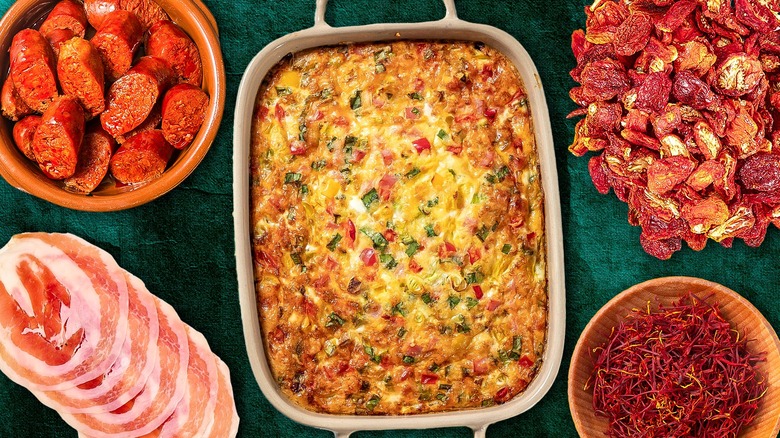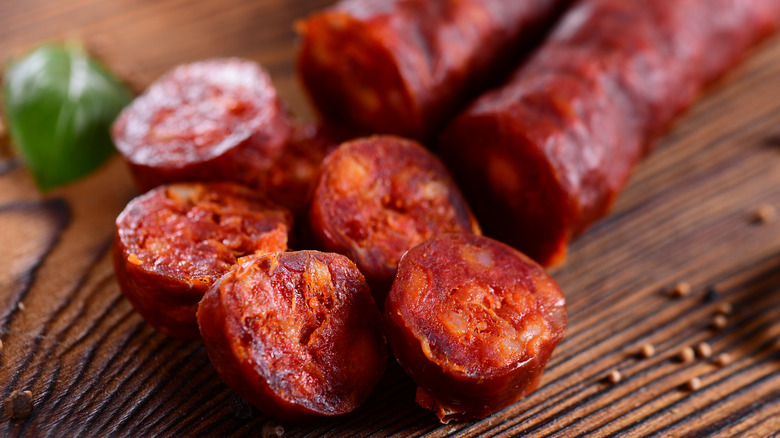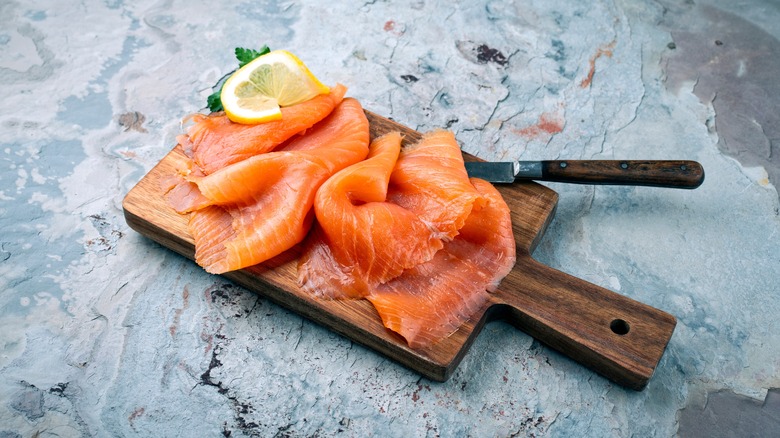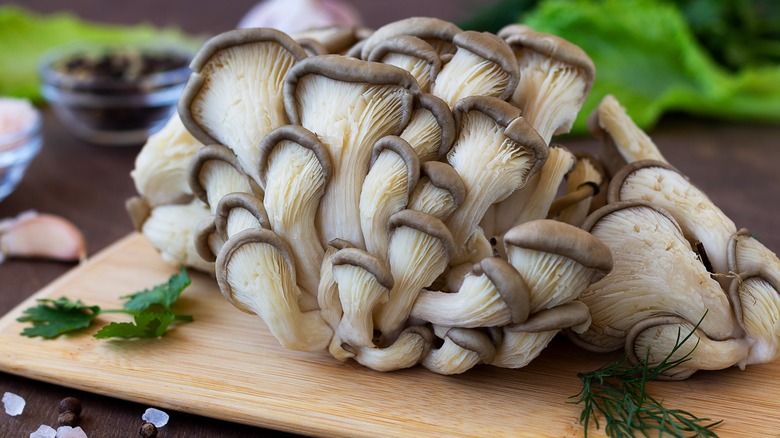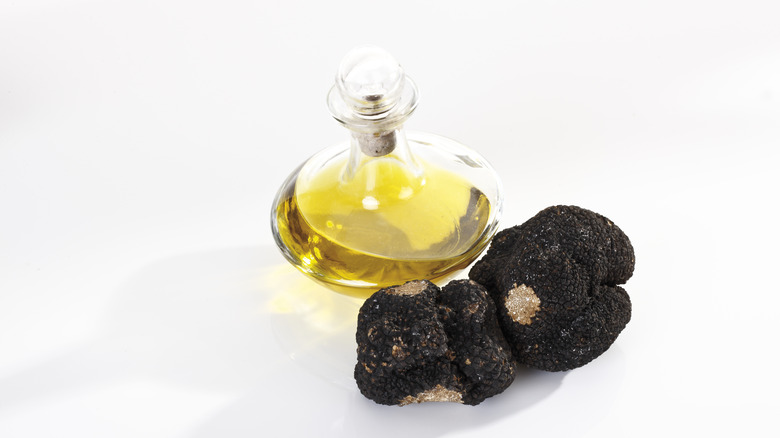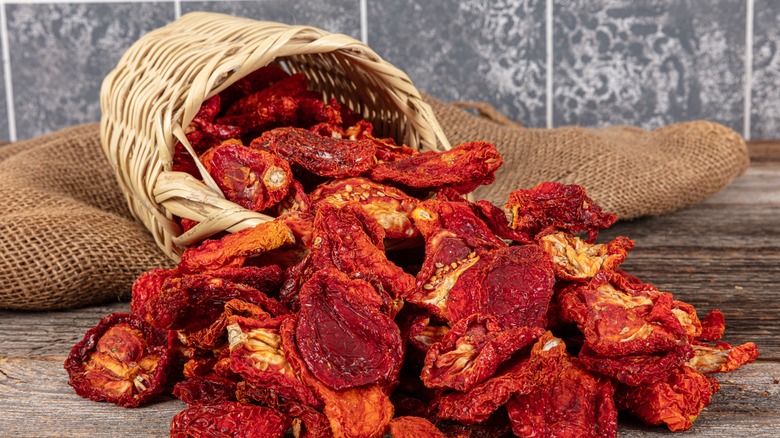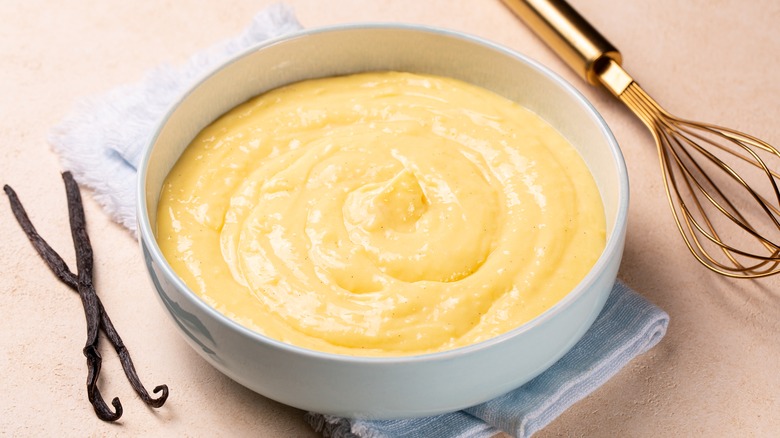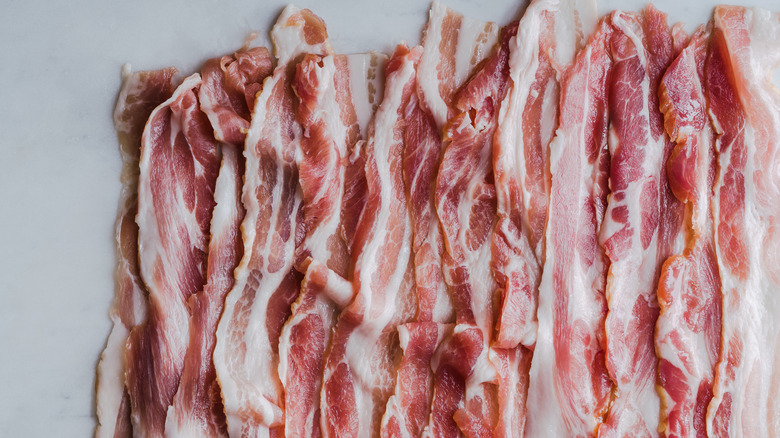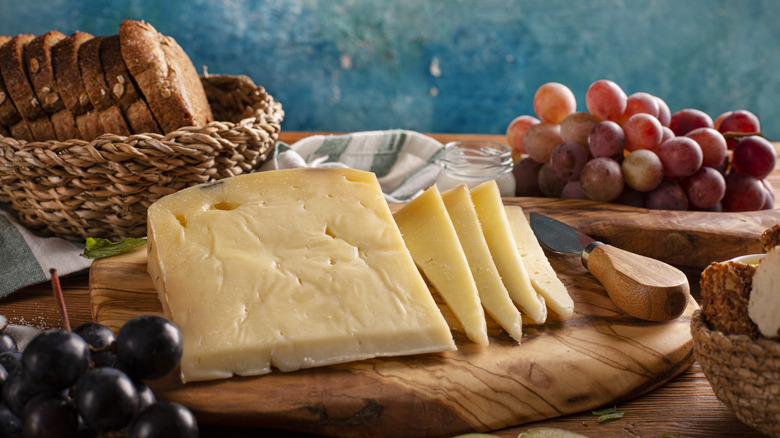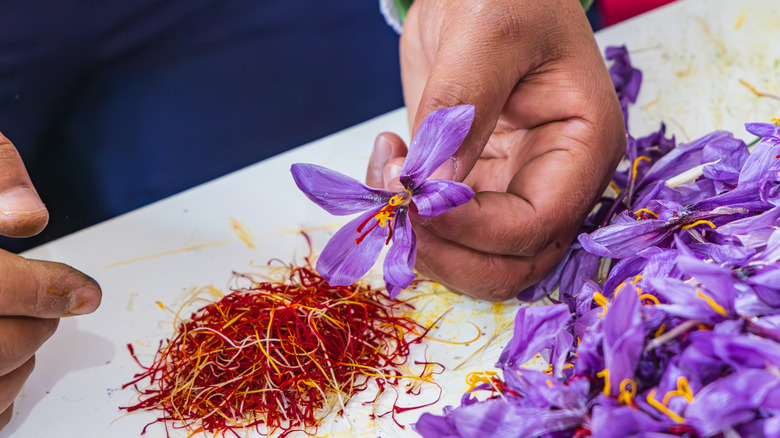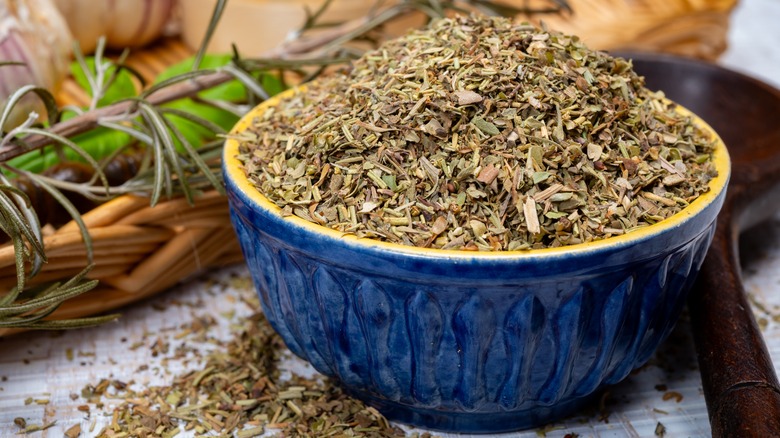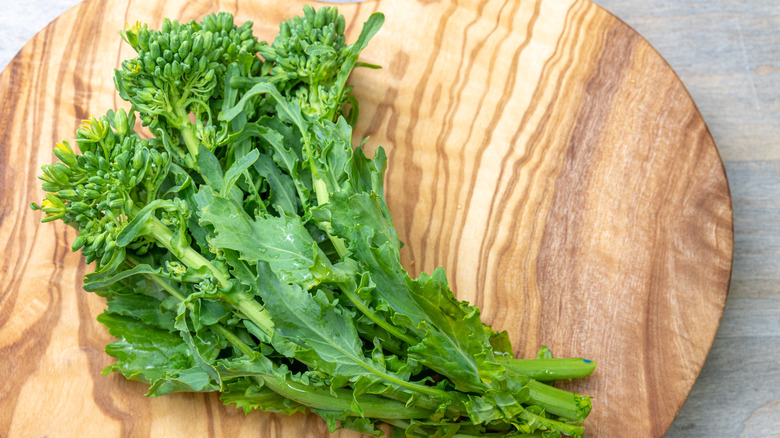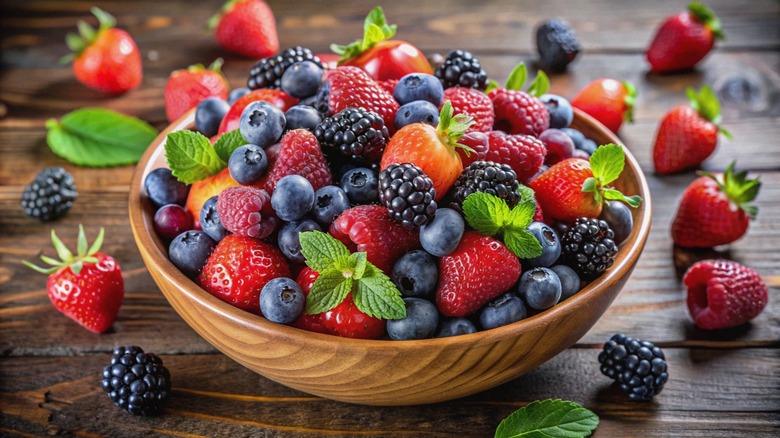12 Elegant Ingredients To Add To Breakfast Casserole
From a creamy carrot casserole to a loaded beef taco casserole, there are endless ways to tailor this blank slate of a dish so it perfectly suits your taste buds. And because of its customizable nature, casseroles are a great option for any meal of the day. The dish is already a popular, go-to option for lunch and dinner, but it shouldn't be overlooked when it comes to breakfast either. Especially when there are tons of unique and elegant ingredients to add.
When thinking about breakfast casseroles, your mind might immediately go to the ingredients that are often used in them, such as bacon, hash browns, and sausages. And while these items are classic and comforting for a reason, there's no harm in experimenting with new elements for an upgraded meal. The addition of just a few unique veggies, proteins, or sauces can make your casserole fit for any elegant morning. Try the following suggestions of what to add to breakfast casseroles the next time the craving for a hearty, elevated meal hits.
Chorizo
Most people will probably reach for breakfast sausages or bacon when putting together a breakfast casserole. Those are perfectly fine choices, but to switch it up a bit, opt for chorizo instead. This type of sausage originated in Spain. It's widely known for its bold and spicy flavor, making it a perfectly delicious way to wake people up in the morning.
What's inside the chorizo depends on where exactly it was made, but most Spanish varieties will contain pork, smoked paprika, and garlic. The smoky flavors from these ingredients lend themselves well to the commonly used cheese and eggs, as their respective dairy and creaminess will help offset the heat in the casserole.
Chorizo also makes for a hearty and more filling addition than other ingredients. Try using this fatty sausage in any casserole recipe where you'd typically use breakfast sausage, and load it up with hash browns, peppers, and bread for all the breakfast go-to's one could ask for in one dish.
Smoked salmon
For a more unique protein source, turn to smoked salmon. Bear in mind, though, that there are differences between lox and smoked salmon in case you were thinking they could be used interchangeably to achieve the same effect. Lox is a strip of salmon that has been salt-cured to better preserve it. Smoked salmon, on the other hand, may or may not be cured. Its defining characteristic is that it has either been cold- or hot-smoked, as hinted by the food's name. The cold-smoked version is raw, while the hot-smoked version is cooked. Either one will provide that deep, toasty flavor your breakfast can benefit from.
Scott Groth, a trained chef and food blogger at I'd Rather Be a Chef, shared a specific way to add the salmon to breakfast casseroles. "After baking the custard base, the smoked salmon is layered on, with dollops of crème fraîche and a garnish of fresh dill," he said. This combination creates a refreshing and delicate taste that Groth says is best paired with Brut Champagne. Try it for your next brunch get-together.
Wild mushrooms
Mushrooms have become a popular addition to both casual and elegant dining. They can be enjoyed in anything from burgers and pastas to rice dishes, and, you guessed it, breakfast casseroles. Some of the most popular types of mushrooms are cultivated, while the others are considered wild, meaning they're able to be picked from their natural environment.
According to Scott Groth, wild mushrooms are a great way to add an umami flavor to your casserole. There are several of them that can add a rich taste, but beware, as a common mushroom mistake everyone needs to stop making is choosing the wrong type for your dish. Groth names hen-of-the-woods, porcini, oyster, and chanterelle mushrooms as great picks, saying, "Paired with eggs, cream, garlic, shallots, fresh herbs, and topped with Fontina cheese, the result is nothing short of spectacular."
The key to adding them to the dish, according to Groth, is to "cook off enough moisture from the mushrooms so the casserole sets, or to include some crunchy, cubed baguette in the casserole to absorb the flavors." Flavor boost aside, wait until you hear of the nutrients found in wild mushrooms. Potassium, fiber, and vitamin C are found in these fungi, making them a healthy addition to the most important meal of the day.
Truffle oil
If you already add truffle oil to scrambled eggs, why not take it up a notch and put it on the eggs within a casserole? Add some potatoes, bacon, or high-quality sausage in there, and you've got yourself a complete meal. Or as Scott Groth recommends, try it in a breakfast casserole with spinach and mushrooms. "The key to this recipe is to ensure the mushrooms and spinach are well drained, so the casserole sets properly," he said. "The truffle oil is added sparingly just before baking, under a nice layer of freshly shaved Parmesan cheese."
Whichever route you take, only a small amount of the oil is needed to transform your dish with its potent flavor. Keep in mind that there are multiple types of truffle oil to choose from, though, and that the kind you pick will determine how your breakfast casserole tastes. Black and white truffles are the most widely eaten varieties, and there are differences between the two. Black truffle oil, for example, has a robust flavor and clear earthy tones, whereas white truffle oil is much softer with an aroma of onions and garlic.
Sun-dried tomatoes
Add a vibrant pop of color to your casserole with some sun-dried tomatoes. The rich red and brown-orange hue of these vine-grown fruits will stand out among yellow-toned ingredients like eggs, potatoes, and cheese. And more importantly, of course, the taste will do wonders. Chef Robert Smith, who is a part of the team at Culinary Collective ATL, a personal chef service, says sun-dried tomatoes "can add a burst of flavor and a touch of acidity, balancing the richness of the eggs and cheese."
Sun-dried tomatoes are an especially elegant choice to achieve that effect considering they're imported from places like southern Italy. Dusted with salt, laid out in the sun to dry, and preserved in olive oil, your tastebuds will be immersed in a tangy yet slightly sweet explosion. The loss of moisture in these smaller tomatoes, whether from the sun, a dehydrator, or the oven, is what boosts their flavor to the max and creates the chewy texture of the fruit is known for.
Crème anglaise
Many sweet treats and pastries are made with a pale yellow, velvety custard sauce called crème anglaise. This French ingredient is created from just a few simple components, including cream, vanilla, egg yolks, and sugar. It's often used as a base for ice cream, but with its silk-like, runny consistency, it's also easily poured atop fruits, cakes, pies, and other desserts.
Add casseroles to that list, too, as crème anglaise can be used in them just as well. It'll work perfectly for a French toast casserole in particular. As suggested by Cynthia Christensen, the founder of But First We Brunch, you can use it in place of maple syrup for a more "grown-up" feel. Just drizzle it over your casserole slice before eating. And if you don't have the time to whip up crème anglaise from scratch, you can melt a high-quality vanilla ice cream as a substitute, and no one will be able to tell the difference, according to Christensen.
Pancetta
Originating from Italy, pancetta is salt-cured pork belly. It's also sometimes cured in a mixture of other spices, such as nutmeg, black pepper, cinnamon, and chili flakes. But even with this blend of seasonings, pancetta maintains a deeper pork flavor than smoky strips of bacon, which is the protein source you'll often find when cutting into a breakfast casserole.
With its smoky, savory goodness, bacon is certainly well-loved and used often for a reason, but it's typically used in more casual settings. You'll commonly find it in pizza, and you'll even find it in burgers, so if you're looking for an upscale alternative that feels more appropriate for special occasions, give pancetta a go instead. It can still provide a similarly savory experience for your morning meal while adding some sophistication at the same time.
Gruyère
Since cheese frequently serves as a fundamental ingredient in breakfast casseroles, choosing a gourmet one can be a key way to elevate the entire dish. So swap that cheddar and mozzarella cheese for some Gruyère instead. A type of yellow Swiss cheese, Gruyère is made from raw cow's milk and is a versatile ingredient that can be added to breakfast casseroles that have a variety of ingredients, from spinach and caramelized onions to pancetta and sausage.
This complex dairy product is distinguished by its nutty and salty flavor as well as its semi-firm to firm yet creamy texture. When young, it has a milder taste that gets sharper as it ages. But what makes this ingredient particularly great for a breakfast casserole, especially while it's still young, is that it's one of the many cheeses that are excellent for melting. That's thanks to its high water-to-oil ratio. Its water content is responsible for making the cheese melt evenly rather than creating pools of fat.
Saffron
Just about any meal can be elevated with the incorporation of saffron. Coming from the crocus sativus plant, this luxurious spice is thought to have originated in Greece, but today, it's grown and cultivated in several other places, too, including but not limited to Iran, India, and Morocco. It takes on the form of thin reddish-brown threads, which are delicate in both composition and flavor. The taste of the spice can be described as overall subtle with a slight bitterness to it at the start, followed by floral and honey notes.
The only downside to this elegant ingredient is its high price tag, typically costing a minimum of $10 per gram. It's not called red gold for nothing, as saffron is harvested by hand, and just one ounce of the spice usually calls for 1,000 flowers. Luckily, not much of it is necessary to reap its effects when cooking. A little goes a long way when it comes to saffron; just a few threads in your casserole can impart earthy notes and a beautiful yellow hue.
Herbs de Provence
Seasonings, or the lack thereof, are what make or break a dish, and a breakfast casserole is no exception. Of course, you've got your usual salt and pepper, and it's common for people to work in things like cumin, paprika, garlic, and onion powder, too. But if you'd like a touch of elegance, you can't go wrong with Herbs de Provence.
This mixture originating from the south of France contains a varied blend of rosemary, thyme, basil, savory, tarragon, oregano, marjoram, and bay leaf. It can be incorporated into virtually everything, though it's most often used to flavor poultry, lamb, and fish before the cooking process. If you need ideas for how to use it in your breakfast casserole, try playing around with French- and Mediterranean-inspired recipes, as those are the cuisines the seasoning is often used in. Chef Robert Smith says it can be thrown right into the casserole's egg mixture, or you could also sprinkle it on top of the finished dish instead. Either way, the Herbs de Provence help create a more complex, aromatic meal that contains both sweet and savory touches.
Broccoli rabe
Despite their shared name, broccoli rabe and broccoli are not the same and should not be substituted for one another when cooking. Broccoli, whether you hate it or love it, is the famously green, stout veggie that's packed full of vitamins and minerals. While broccoli rabe also has its own number of health benefits like protein and fiber, it's much leafier looking, less tough in texture, and is more slender in shape. The biggest difference, however, is the taste. Broccoli rabe has a very bitter flavor that's said to diminish only once it's cooked.
Surprisingly enough, its bitterness is what makes broccoli rabe a shining ingredient when used in casserole dishes. The sharp, bold flavor is good for breaking up the taste of protein and heavier sauces. So try throwing it into breakfast casseroles with cheese, heavy cream, and spicy sausage. But if you still want to cut that bitterness down even more, blanch the veggie before putting it into the casserole. And if you're looking to maintain a paleo- or keto-friendly diet, broccoli rabe is a superstar for that purpose.
Fresh fruit
As simple as it may sound, fresh fruit is a wonderful addition to your morning meal. It can be incorporated into your dish in a variety of ways, whether you're kick-starting your day with a French toast casserole, a casserole that's croissant-based, or any casserole that's loaded up with cream cheese or oats. And the best part is, it's an easily accessible ingredient that can be purchased from any local grocery store, and you can choose the fruit that best suits your taste and complements the casserole's other ingredients.
Some reliable options to try include strawberries, blueberries, blackberries, and raspberries. Blair Lonergan, the founder of The Seasoned Mom, says that berries will "cut through the buttery, flaky layers" of a croissant-based casserole, for example. But you can't go wrong with any fruit you choose. Even apples or peaches are a solid choice that can be used in a casserole to mimic pies. Not to mention, these fruits will add a lovely splash of color to the dish and brighten up its aesthetic.
